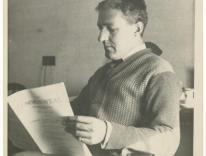When I was in Catholic grade school (in the late 1980s-early '90s), I can remember being encouraged to pray for the intercession and eventual canonization of then-Blessed Kateri Tekakwitha. I don't know what inspired our teachers to bring her to our attention, besides her fairly recent beatification (in 1980). Maybe they were flush with success after the 1975 canonization of St. Elizabeth Seton -- the patron of Catholic schools, as we were so often reminded -- and were hoping to energize us with another American cause. Or perhaps they assumed, correctly in my case, that she was a figure who would appeal to our young imaginations: American like us and yet exotic, a figure who stood out from the crowd of saints with whom we were familiar; a laywoman, and young at that, when she made her courageous commitment to Christ. Probably, too, the story of Kateri fit in well with a curriculum, and as I recall a wider culture, that was heavy on the study of Native Americans -- a sudden burst of respectful attention to compensate for many decades of neglect and worse. As I look back, I remember learning a lot about American Indian nations and their ways of life in grade school: who lived where, in what sort of dwelling, wearing what, and so forth. As older kids we got more information about where all those noble tribes disappeared to, and why. I couldn't summon many details from my social-studies books now, but the general sense of respect and awe has stuck with me.
Thus my ten-year-old self is very pleased that Kateri Tekakwitha has become a saint at last, though perhaps without much help from me. Kathleen Sprows Cummings's article in our June 1 issue (subscription required) is a fascinating look at the circumstances that led to her canonization last October, after a journey of more than a century. Cummings explains what made Kateri a promising candidate when the U.S. bishops opened her cause in 1884, and how her cause fell out of style in the generations that followed. Other home-grown saints surpassed her in popularity -- almost always women, hence the article's title, "Native Daughters" -- and Cummings proposes that their varying fortunes reveal something about the eras in which they were elevated. We like to think that there's a timeless standard of "holiness," and exemplars of that standard will be easily identifiable in any era. But as Cummings shows, different times call for different models of holiness, and the same person's story can be put to different uses depending on the needs of the day. It's another angle on the story of who gets to official sainthood, and when, and why.
As for Kateri Tekakwitha, she might never have been canonized had it not been for significant developments both in the Catholic Church and in American culture. One was the 1979 election of John Paul II, who streamlined the saint-making process, in part to give Catholics from nations without wealth or influence a better chance to secure saints of their own....
By then the Lily of the Mohawks symbolized something quite different from the Tekakwitha whose name had appeared on the Baltimore petition a century before. No longer an effective national symbol, she had reemerged as an ethnic one. Since the 1970s, Tekakwithas most enthusiastic devotees have been Native-American Catholics, both in Canada and in the United States. It is telling that while all U.S. church leaders had supported the 1884 petition that initiated her cause, only one issued a public statement when it finally succeeded: Archbishop Charles Chaput of Philadelphia, the lone Native American in the hierarchy.
While celebrating the "tangible signs of inculturation" that greeted the canonization of Tekakwitha and Marianne Cope, Cummings also worries that "in 1884, canonization offered the American church divided then, as now, by ethnic and ideological conflict a way to rally behind a common goal. Today, canonization reveals just how tribal U.S. Catholicism has become." Read the article. What do you think?


